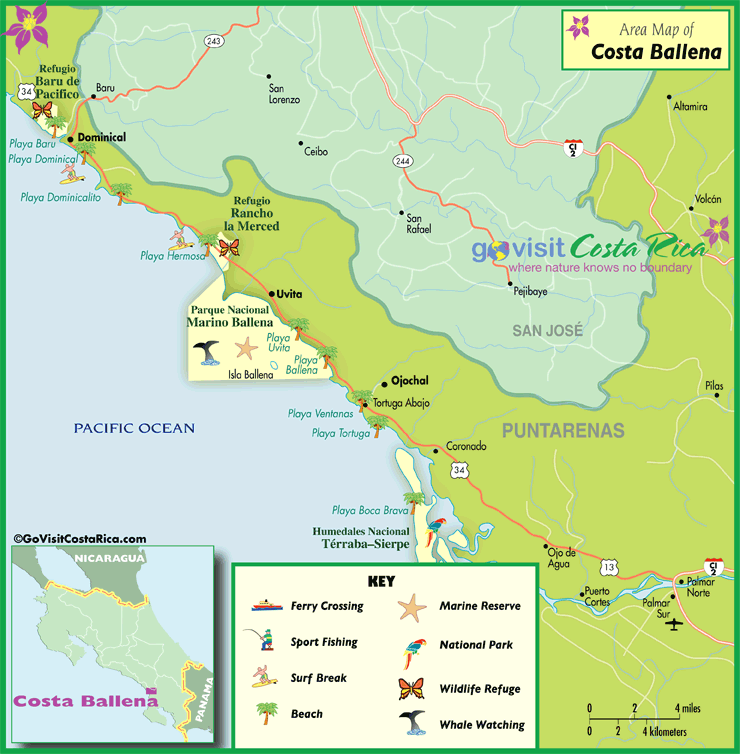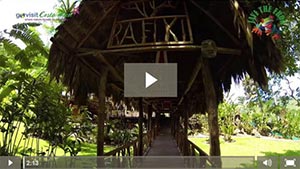Ballena National Marine Park, South Puntarenas
Ballena National Marine Park is one of the most unique reserves in Costa Rica. Located just offshore along the Central Pacific coast in South Puntarenas, the Ballena National Marine Park protects more than 13,000 acres of ocean and 9 miles of coastline. Comprised of mangrove forests, coral reefs and untouched beaches, the national park is one for travelers who want to view fragile wildlife while escaping the hustle and bustle of everyday life.
The park is named after the humpback whales that migrate to the region from August to November (heading north from Antarctica) and December to April (heading south from Alaska), each year. With the whale migration happening much of the year it is a great place to go whale watching. The area was declared a national park in 1989 in order to protect the creatures that migrated here for breeding and feeding purposes. Even the shape of the area from above looks like a fin of a whale! Ballena National Marine Park spans 110 hectares of land and 5,375 hectares of sea. There are approximately 85 species endemic to the waters of this area.
The landscape of Marino Ballena National Park varies depending on the tide. When the tide is low, travelers can take a leisurely stroll to the Punta Uvita Tombola, which is the whale tail of the area. Rocky formations appear about 1 kilometer from the shore. As one of the most prominent and unusual land formations, the Punta Uvita Whale Tail is a must-see for travelers.
Beaches of Ballena National Marine Park
The beaches here are fairly deserted because they are protected as a national park, making them serene and peaceful shorelines to explore. As the surf can get a bit dangerous in the area, there are small little swimming holes created by sea currents that are calming and safe. Golden sandy beaches, rocky shorelines and beautiful coral reefs are just a few of the reasons why travelers and locals come here. There are also several small islands to enjoy.
Map of the Area

There are four beaches in the park: Playa Bahia Ballena, Playa Pinuela, Playa Colonia and Playa Uvita. With the main ranger station located at Playa Bahia Ballena.
One of the most popular activities, besides whale watching, is snorkeling by the coral reef. The Ballena National Marine Park consists of 18 coral species, making it one of the largest collections of coral in the country. Within the park's boundaries, travelers can dive and snorkel through eight coral communities and two coral reefs that include species like Stony Coral, Cauliflower Coral and Star Column Coral.
Wildlife
The national park is home to a variety of avian marine species, including frigates, brown boobies and pelicans. Bird watching is a popular activity here, and travelers can do so aboard a boat or on the shore. But many people travel here for the rare marine life like humpback whales and olive ridley sea turtles. Other species here are bottle-nose dolphins, sharks, starfish, false orca, green iguana, leatherback turtles and bryde's whales. Olive ridley and hawksbill sea turtles nest along the shores of Playa Bahia Ballena between May and November. Roughly 70 species of fish swim in the waters of Ballena National Marine Park. As an underwater marine national park, this reserve is simply intended to protect the lives of endangered and fragile creatures in the area.
Getting to Ballena National Marine Park
Travelers can easily reach this park from San Jose by driving or taking a domestic flight to the Quepos local airport. From Quepos, the drive is along a well-paved road, the Costanera Sur Highway, and is about 67 kilometers. Driving directly from San Jose is also possible, but it is about 190 kilometers and will take roughly 3 hours.
12 Days / 11 Nights or 10 Days / 9 Nights
Starting at $2,352 per person
11 Days / 10 Nights
Starting at $3,874 per person







.jpg)




.jpg)



